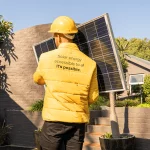Blog
Solar Power Generation: A 2024 Comprehensive Guide
Are you a homeowner who’s struggling with the increasing energy bills? Do you own a business and want to focus on sustainability and reducing your carbon footprint?
Are you a homeowner who’s struggling with the increasing energy bills? Do you own a business and want to focus on sustainability and reducing your carbon footprint?
Welcome to our in-depth guide on mastering solar power generation in 2024. This guide is tailored to provide the knowledge needed to benefit from the sun’s power efficiently.
The significance of solar power is more crucial than ever. As we navigate through the advancements and opportunities that 2024 brings, you’ll discover how solar energy can change our approach to power generation for a brighter, cleaner future. Join us on this journey and uncover the transformative potential of solar power generation.
So, what is solar power generation and what exactly does it involve?
In simple words, it is the process of converting sunlight into electricity using solar panels or photovoltaic systems.
This renewable energy source offers a sustainable and eco-friendly alternative to fossil fuels, significantly reducing our carbon footprint and dependence on non-renewable resources. Relying on solar power to run home appliances and industrial equipment is associated with less negative environmental impact and significant financial savings.
According to recent statistics, the UK has an installed solar capacity of 15.7 gigawatts (GW) as of December 2023.
So, how exactly can we benefit from the sun’s energy?
Solar power generation relies on solar panels that capture sunlight and convert it into electricity. These panels are made of photovoltaic or PV cells, which generate an electric current when exposed to sunlight.
Solar power generation involves producing clean energy that supports many applications, from residential energy needs to large-scale commercial and industrial operations. This is why Statera’s Culham BESS (Battery Energy Storage System) is scheduled to connect to the Culham substation in 2027, providing greater power security according to the Solar Power Portal.
Understanding how solar PV systems work might seem too technical, yet it’s important to grasp how this technology operates as it impacts your residential or commercial property.
The main component of solar systems is PV cells. These PV cells charge electrons, allowing them to create an electric current that’s used to power homes and businesses.
According to IEA, utility-scale PV power plants accounted for 70% of total solar electricity generation in 2022.
But PV cells aren’t the only component of solar power systems. These systems are made of several pieces that operate together to generate electricity that can be later used for various applications. The following section outlines each component and highlights its importance.
Commonly known as solar panels, these are the main components of every solar power generation system. These modules are made of solar cells that absorb the sunlight which is then converted into electric energy.
Various types of solar modules are available to fit different needs, budgets, and applications. According to a study, solar panel efficiency has increased from 14% in the 1960s to over 22% as of 2023 with these different types:
All PV modules do is absorb the solar energy and change it into DC electricity. The inverters are responsible for changing this solar power into electric energy that can be used for lighting, powering machines, appliances, and industrial equipment.
DC electric energy isn’t used in households and industrial properties because it generates more heat, increasing fire hazards. This is why inverters are crucial as they convert DC into AC or alternating current. AC is fed into the grid and used for all residential and industrial applications.
Just like PV modules, inverters come in various types:
Ideally, your solar panel system will work when there’s enough sunlight to be absorbed by the PV cells. But what if you don’t use all this energy? What happens at night or on cloudy days?
This is where batteries shine. These devices store all the excess electricity produced, ensuring continuous electric supply and improving your solar system’s efficiency.
Batteries store DC power, which is used when it doesn’t produce any DC power, like at night. These batteries are available in various types:
The successful installation of a solar panel system involves several steps. Proper maintenance guarantees that the system will continue to operate for decades without issues. The following section explains the factors necessary for efficiently installing a solar power generation system.
Statera is currently building a 300MW battery at Tilbury Substation in Essex.
Several key steps should be followed to guarantee successful and efficient solar panel installation. Ignoring any step will result in a system that doesn’t operate efficiently or fails prematurely.
Site Assessment and System Design
Which system setup will work for your site?
This is the first question to ask when thinking about installing a solar panel system. The roof orientation, overall size, available space for installation, and shading will affect the choice of the type of PV cells, the adequate number of cells, inverters, and batteries for proper system design.
Ignoring any of these factors in the site assessment process will result in a solar system that doesn’t suit your energy needs or layout.
Permitting and Installation
Before installing a solar panel system, you need to ensure you are following all local and national guidelines. The permitting process for residential properties isn’t complicated, as most towns and cities consider installing solar systems permitted for development as long as they don’t protrude more than 20 cm from the roof or wall.
Prior to installation, planning permits might be needed if your property is located in a conservation area. If your building is listed, you’ll need special permits from your local council.
Building regulations approval guarantees that your solar panels won’t affect the structure’s stability. You’ll also need permission from the local Distribution Network Operator to connect your system to the grid.
Regular maintenance is crucial to ensure optimal operation of solar systems, resulting in long-term economic and environmental benefits.
Your system’s life depends on the nature and quality of various components and how properly they’re taken care of. Cleaning solar panels, inspecting the system for damage, and ensuring that all components function properly leads to maximum energy output.
With proper maintenance, solar panels should last 25 years or more, but inverters need replacement after around 12 years.
But why are people, organisations, and governments switching to solar energy?
Solar power represents a clean and renewable source that reduces stress on the traditional grid. Relying on these systems results in massive financial savings in addition to positive environmental benefits.
The tradeoff between the initial upfront costs of investing in solar systems and the return on investment is crucial to consider. As a matter of fact, the financial benefits and massive cost savings that come from using renewable solar power instead of relying on the grid represent one of the main reasons why solar panel installation is becoming more popular.
In addition to lower energy bills that result in massive savings in the long run, government incentives also make these systems more appealing as the cost of solar panels is decreasing with more models available. Reports show that the inflation-adjusted cost of solar panels in the UK has fallen by 25% since 2013/14.
Installing solar panels lets you use free, renewable, low-carbon electricity. You can sell surplus electricity to the grid or store it for later use.
Yet, the increasing cost of living as well as the cost of installing solar panels stand as an obstacle hindering people who want to switch to renewable energy.
The UK government grants several incentives and rebates to make the process of choosing and installing solar panel systems more affordable.
These plans help with the upfront installation costs, making switching to solar power more accessible. Each one has different eligibility criteria:
Solar panels don’t rely on fossil fuel, this is why they produce clean energy. They don’t pollute the air and reduce greenhouse gas emissions that negatively impact the environment.
By relying on this clean and sustainable energy, individuals and businesses can reduce their carbon footprint and combat climate change. One study showed that solar PV systems installed in 2020 alone cut carbon dioxide emissions by approximately 2.6 billion tonnes.
With all these benefits, many people would rush to install solar energy panels. But why isn’t this happening?
Despite its numerous benefits, several challenges and obstacles limit using renewable solar power. These challenges include intermittent energy production, high initial costs, and the necessity for suitable installation sites:
However, advancements in solar technology with more reliable panels, batteries with better storage abilities, and more durable inverters promise a brighter future for this technology and its applications on residential and industrial levels.
The previous challenges can be mitigated by implementing several strategies and solutions:
The smart solar power market is projected to reach approximately £36.25 billion by 2031. And with this increase, the need for reliable energy storage solutions will grow.
Energy storage solutions represent a crucial component of solar panels and are meant to overcome intermittent energy production. Different solutions have various benefits:
The newest industry trends and technological advancements aim to make solar power generation more affordable and reliable. For example, researchers have developed PV cells with efficiencies approaching 50%. Some other advancements include the following.
With these improvements, Space Solar aims to generate gigawatt-scale electricity from space in the early 2030s.
Solar power has several real-world applications that showcase the bright future of this energy technology. Current case studies show that most solar systems installed in residential buildings are 15% to 23% efficient with some expensive systems reaching an efficiency rate of 50%.
Yet, the ability of PV modules to generate electricity is excellent. These systems are expected to go through several upgrades in the coming year to make solar power generation more affordable and accessible.
Recent studies show that around two-thirds of adults in the UK want solar panels. This increasing demand for solar systems along with the proven cost savings make switching to renewable energy more appealing.
More people are encouraged to install residential solar power systems to benefit from government grants and tax exemptions. Also, technological advancements decrease the prices of home solar panels, making this technology more affordable.
The South East region of England has the most solar panel installations in the UK, with a total of 178,954. Commercial solar power systems decrease the overall production costs, increasing profits in the long run.
Many businesses and industrial buildings invest in and install industrial solar power systems to achieve sustainability goals and decrease their carbon footprint. These make them more appealing to environmentally-conscious consumers who want to limit air pollution and climate change due to the use of fossil fuels.
Instead of relying on fossil fuels, utility-scale solar power systems capture solar energy to generate electricity for the grid. These solar power plants are still limited in use but can diversify the energy mix in a region.
With proper planning, solar plants can generate huge amounts of clean energy, but adequate land selection, installation, and integration with the grid remain obstacles.
Yet, thanks to the new technological advancements, utility-scale solar PV is the least costly option for new electricity generation in a significant majority of countries worldwide.
Utility-scale solar projects represent the future of electricity production in multiple countries. They can generate substantial amounts of clean electricity with reduced costs and less environmental impact.
However, land use, government permits, and grid integration limit the spread of solar power plants. Careful planning and coordination are essential to meet regulatory standards and help these projects expand.
The Longyangxia Dam Solar Park in China, Pavagada Solar Park in India, and Noor Complex in Morocco are all examples of these applications.
Our comprehensive guide for solar power generation has covered several key points. Here are the main ones:
Switching to solar energy is a must. With the rising costs of fossil fuels and the continuous threats of climate change, solar power generation provides various advantages in residential, commercial, and industrial applications.
Take a step towards a healthier and cleaner future, and contact the experts at Soly to assess your energy needs.
Soly’s experts will thoroughly assess your situation to suggest the best solar energy solution for your building. Then, they will carefully install it and follow up with permits and maintenance to guarantee optimal operation.



